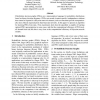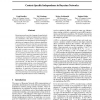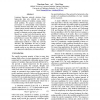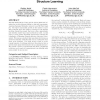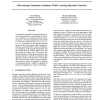JMLR
2010
13 years 11 months ago
2010
We propose to solve the combinatorial problem of finding the highest scoring Bayesian network structure from data. This structure learning problem can be viewed as an inference pr...
ML
2006
ACM
14 years 5 months ago
2006
ACM
We present a new algorithm for Bayesian network structure learning, called Max-Min Hill-Climbing (MMHC). The algorithm combines ideas from local learning, constraint-based, and sea...
IJAR
2006
14 years 5 months ago
2006
Probabilistic decision graphs (PDGs) are a representation language for probability distributions based on binary decision diagrams. PDGs can encode (context-specific) independence...
UAI
1996
14 years 6 months ago
1996
Bayesiannetworks provide a languagefor qualitatively representing the conditional independence properties of a distribution. This allows a natural and compact representation of th...
IJCAI
2007
14 years 6 months ago
2007
The task of learning models for many real-world problems requires incorporating domain knowledge into learning algorithms, to enable accurate learning from a realistic volume of t...
ICDM
2003
IEEE
14 years 10 months ago
2003
IEEE
Learning Bayesian network structure from large-scale data sets, without any expertspecified ordering of variables, remains a difficult problem. We propose systematic improvements ...
GECCO
2007
Springer
14 years 11 months ago
2007
Springer
Bayesian Networks are today used in various fields and domains due to their inherent ability to deal with uncertainty. Learning Bayesian Networks, however is an NP-Hard task [7]....
KDD
2004
ACM
15 years 5 months ago
2004
ACM
ICML
1996
IEEE
15 years 5 months ago
1996
IEEE
We introduce a method for learning Bayesian networks that handles the discretization of continuous variables as an integral part of the learning process. The main ingredient in th...
ICML
2009
IEEE
15 years 5 months ago
2009
IEEE
This paper addresses exact learning of Bayesian network structure from data and expert's knowledge based on score functions that are decomposable. First, it describes useful ...

